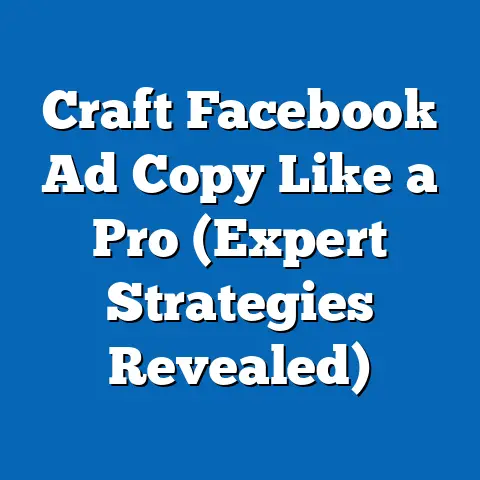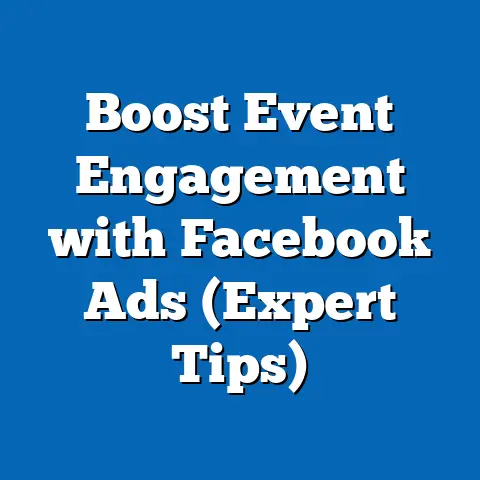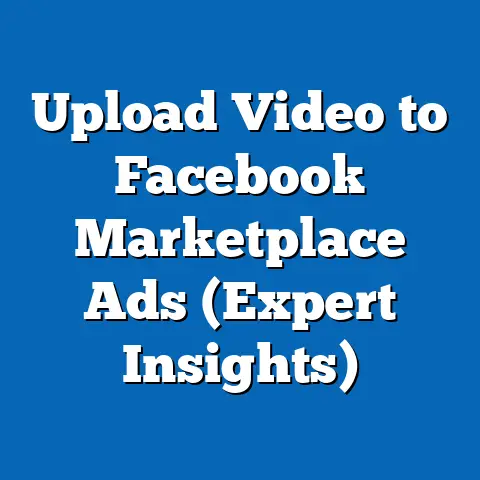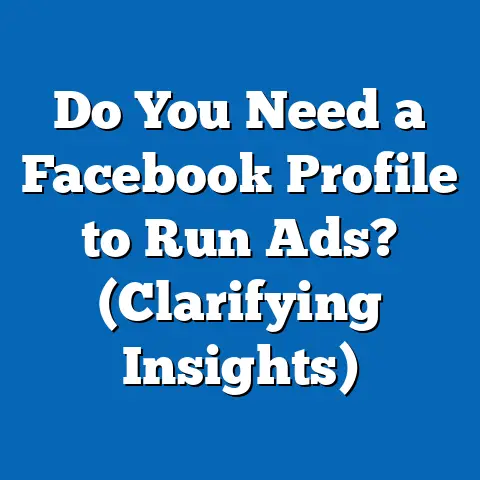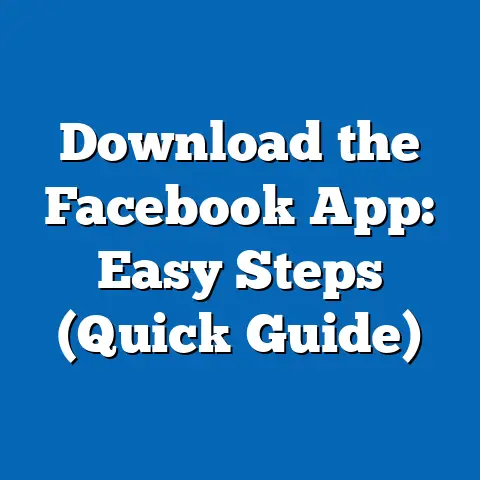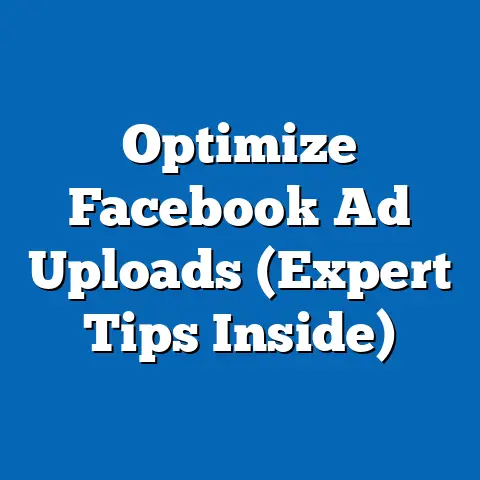Master Facebook Ads Sales Strategies (Proven Techniques)
Imagine a world where your ideal customers effortlessly find you, eager to purchase your products or services. It’s not a fantasy; it’s the power of Facebook Ads, and it’s a game-changer I’ve witnessed firsthand. For years, I’ve been immersed in the ever-evolving landscape of digital marketing, and I can confidently say that Facebook advertising, when done right, is one of the most potent tools available to businesses of all sizes.
I’ve seen startups explode in growth, established companies revitalize their sales, and even local businesses connect with their community in ways they never thought possible – all through the strategic use of Facebook Ads. The platform’s vast reach, coupled with its sophisticated targeting capabilities, allows you to pinpoint your perfect audience with laser-like precision. Forget the days of throwing marketing dollars into the void; Facebook Ads enable you to focus your efforts on those most likely to convert.
But it’s not just about reach; it’s about relevance. Facebook Ads, when crafted with compelling content and targeted with precision, can transform casual browsers into loyal customers. This isn’t just advertising; it’s a conversation, an invitation, a connection. The key is understanding how to leverage the platform effectively, making data-driven decisions, and constantly engaging with your audience.
1. Understanding Facebook Ads
Before we dive into the strategies, let’s lay the foundation by understanding what Facebook Ads are and how they fit into the broader digital marketing landscape.
What are Facebook Ads?
Simply put, Facebook Ads are paid advertisements that appear on Facebook and its related platforms, including Instagram, Messenger, and the Audience Network. They are designed to reach specific audiences based on demographics, interests, behaviors, and other targeting options.
Facebook Ads aren’t just about visibility; they’re about driving action. Whether you want to generate leads, increase website traffic, boost sales, or build brand awareness, Facebook Ads can be tailored to achieve your specific business goals.
Types of Facebook Ads
Facebook offers a variety of ad formats, each with its unique advantages:
- Image Ads: These are the simplest form of Facebook Ads, featuring a single image and accompanying text. They’re great for visually showcasing your products or services and are easy to create.
- Video Ads: Video ads capture attention and tell a story in a more engaging way than static images. They can be used to demonstrate product features, share customer testimonials, or simply entertain your audience.
- Carousel Ads: Carousel ads allow you to showcase multiple images or videos in a single ad unit. This format is ideal for highlighting different products, features, or benefits.
- Collection Ads: Designed specifically for e-commerce, collection ads allow users to browse and purchase products directly from the ad. They’re visually appealing and provide a seamless shopping experience.
- Instant Experience Ads: These are full-screen, mobile-optimized ads that open when someone clicks on your ad. They offer an immersive and interactive experience, perfect for showcasing your brand or products in detail.
Choosing the right ad format depends on your objectives, target audience, and the type of content you want to share. For example, if you’re launching a new product, a video ad demonstrating its features might be the most effective choice. If you have a wide range of products, a carousel ad could be a better option.
The Facebook Advertising Ecosystem
The Facebook advertising ecosystem is a complex but powerful network of tools and features designed to help you reach your target audience and achieve your business goals. Key components include:
- Ads Manager: This is your central hub for creating, managing, and tracking your Facebook Ads campaigns. It provides a comprehensive dashboard where you can set up your campaigns, define your target audience, set your budget, and monitor your performance.
- Audience Segmentation: Facebook’s robust audience segmentation tools allow you to target your ads to specific groups of people based on a wide range of criteria, including demographics, interests, behaviors, and connections.
- Facebook Pixel: The Facebook Pixel is a small piece of code that you install on your website to track user behavior. It allows you to measure the effectiveness of your ads, optimize your campaigns for conversions, and retarget users who have interacted with your website.
My Experience: I remember working with a client who was struggling to generate leads for their SaaS product. We implemented the Facebook Pixel on their website and used it to track users who visited specific landing pages. By retargeting those users with tailored ads, we saw a significant increase in lead generation and conversion rates.
Key Takeaway: Understanding the different types of Facebook Ads and the components of the advertising ecosystem is crucial for creating effective campaigns. Take the time to explore the Ads Manager, experiment with different ad formats, and implement the Facebook Pixel on your website to unlock the full potential of the platform.
2. Crafting Compelling Ad Copy
Now that you understand the basics of Facebook Ads, let’s talk about one of the most critical elements of a successful campaign: compelling ad copy.
The Power of Words
In the fast-paced world of social media, you have mere seconds to capture someone’s attention. Your ad copy is your opportunity to make a strong first impression, pique their interest, and persuade them to take action.
Think of your ad copy as a mini sales pitch. It needs to be clear, concise, and relevant to your target audience. It should highlight the benefits of your product or service and address their pain points. Most importantly, it should include a clear call to action that tells them exactly what you want them to do.
Proven Techniques for Writing Persuasive Ad Copy
Here are some proven techniques for writing ad copy that converts:
- Know Your Audience: Before you start writing, take the time to understand your target audience. What are their needs, desires, and pain points? What language do they use? The more you know about your audience, the better you can tailor your ad copy to resonate with them.
- Highlight the Benefits, Not Just the Features: Focus on how your product or service will improve their lives. What problems will it solve? What benefits will they experience? Instead of saying “Our software has advanced reporting features,” say “Gain valuable insights into your business with our easy-to-use reporting dashboard.”
- Use Strong Action Verbs: Start your call to action with a strong action verb that encourages immediate action. Examples include “Shop Now,” “Learn More,” “Sign Up Today,” and “Get Started.”
- Create a Sense of Urgency: Encourage people to take action now by creating a sense of urgency. Use phrases like “Limited Time Offer,” “While Supplies Last,” and “Don’t Miss Out.”
- Keep it Concise: People scroll quickly through their Facebook feeds, so it’s important to keep your ad copy concise and to the point. Get your message across in as few words as possible.
- Use Emojis: Emojis can add personality and visual appeal to your ad copy, making it stand out in the feed. Use them sparingly and strategically to enhance your message, not distract from it.
Examples of High-Performing Ad Copy
Let’s look at some examples of high-performing ad copy across various industries:
- E-commerce: “Shop our new collection of summer dresses! Perfect for sunny days and warm nights. Limited time offer: Get 20% off your first order. Shop Now!”
- SaaS: “Tired of managing your projects with spreadsheets? Our project management software makes it easy to collaborate with your team and stay on track. Sign up for a free trial today!”
- Local Business: “Join us for our grand opening celebration this Saturday! Enjoy live music, delicious food, and exclusive discounts. RSVP now and get a free gift!”
My Experience: I once worked with a local restaurant that was struggling to attract new customers. We created a Facebook Ad campaign featuring mouthwatering photos of their dishes and ad copy that highlighted their unique atmosphere and friendly service. We also included a limited-time offer for a free appetizer with any entree purchase. The campaign was a huge success, driving a significant increase in foot traffic and sales.
Key Takeaway: Crafting compelling ad copy is essential for capturing attention and driving conversions. By understanding your audience, highlighting the benefits of your product or service, using strong action verbs, and creating a sense of urgency, you can write ad copy that resonates with your target audience and achieves your business goals.
3. Designing Eye-Catching Visuals
While compelling ad copy is crucial, it’s equally important to create visually appealing ads that grab attention and make a lasting impression.
The Power of Visuals
In a world saturated with information, visuals are more important than ever. People are naturally drawn to images and videos, and they’re more likely to remember visual content than text-based content.
Your ad visuals are your opportunity to showcase your brand, highlight your products or services, and create an emotional connection with your audience. They should be high-quality, relevant to your message, and visually appealing.
Guidelines for Creating Visually Appealing Ads
Here are some guidelines for creating visuals that capture attention and drive engagement:
- Use High-Quality Images and Videos: Blurry, pixelated, or poorly lit images can damage your brand’s reputation. Invest in professional-quality images and videos that showcase your products or services in the best possible light.
- Choose Images and Videos That are Relevant to Your Message: Your visuals should directly relate to the message you’re trying to convey. Don’t use generic stock photos that don’t resonate with your target audience.
- Use Branding Consistently: Your ad visuals should reflect your brand’s identity, including your logo, colors, and fonts. This will help you build brand recognition and create a cohesive brand experience.
- Consider Color Psychology: Different colors evoke different emotions. Use color strategically to create the desired mood and tone for your ad. For example, blue is often associated with trust and reliability, while red is associated with excitement and passion.
- Use Minimal Text on Images: Facebook has strict guidelines about the amount of text that can appear on ad images. Too much text can negatively impact your ad’s reach. Keep your text concise and use it sparingly.
- Test Different Visuals: Experiment with different images and videos to see what resonates best with your target audience. A/B testing can help you identify the visuals that drive the highest engagement and conversion rates.
Tools and Resources for Designing Professional-Quality Ads
Fortunately, you don’t need to be a professional designer to create visually appealing ads. There are many tools and resources available that can help you create professional-quality visuals:
- Canva: Canva is a user-friendly graphic design tool that offers a wide range of templates, images, and fonts. It’s perfect for creating eye-catching ad graphics, social media posts, and other marketing materials.
- Adobe Spark: Adobe Spark is another popular graphic design tool that offers a variety of templates and design features. It’s great for creating animated videos, social graphics, and web pages.
- Unsplash and Pexels: These are websites that offer free, high-quality stock photos that you can use in your ads.
- Animoto: Animoto is a video creation tool that allows you to easily create professional-looking videos using templates and drag-and-drop features.
My Experience: I worked with a clothing boutique that had beautiful products but their Facebook Ads were falling flat. The images they were using were low-resolution and didn’t showcase the quality of their clothing. We invested in professional product photography and created visually stunning ads that highlighted the details and craftsmanship of their clothing. The result was a significant increase in sales and brand awareness.
Key Takeaway: Designing eye-catching visuals is crucial for capturing attention and making a lasting impression. By using high-quality images and videos, branding your ads consistently, considering color psychology, and testing different visuals, you can create ads that resonate with your target audience and drive results.
4. Targeting the Right Audience
You could have the most compelling ad copy and stunning visuals in the world, but if you’re not targeting the right audience, your ads will fall flat.
The Importance of Audience Targeting
Audience targeting is the process of identifying and reaching specific groups of people with your ads. It’s one of the most powerful features of Facebook Ads, allowing you to focus your efforts on those most likely to be interested in your products or services.
Targeting the right audience is essential for several reasons:
- Increased Relevance: When you target your ads to people who are genuinely interested in your products or services, your ads become more relevant and engaging.
- Improved Conversion Rates: Targeting the right audience can significantly improve your conversion rates, as you’re reaching people who are more likely to take the desired action, whether it’s making a purchase, signing up for a newsletter, or visiting your website.
- Reduced Advertising Costs: By focusing your efforts on a smaller, more targeted audience, you can reduce your advertising costs and get more bang for your buck.
Facebook’s Targeting Options
Facebook offers a wide range of targeting options, allowing you to reach your ideal customers with laser-like precision:
- Demographics: You can target people based on their age, gender, location, education, job title, and other demographic information.
- Interests: You can target people based on their interests, hobbies, and passions. Facebook gathers this information from the pages they like, the groups they join, and the content they engage with.
- Behaviors: You can target people based on their online behavior, such as their purchase history, the websites they visit, and the apps they use.
- Custom Audiences: You can create custom audiences based on your existing customer data, such as email lists, phone numbers, and website visitors. This allows you to retarget people who have already interacted with your business.
- Lookalike Audiences: You can create lookalike audiences based on your existing customer data. Facebook will identify people who share similar characteristics and behaviors with your best customers, allowing you to reach new potential customers who are likely to be interested in your products or services.
A/B Testing Different Audiences
The key to successful audience targeting is experimentation. Don’t be afraid to A/B test different audiences to see which segments yield the highest conversion rates.
Create multiple ad sets, each targeting a different audience segment. Monitor the performance of each ad set closely and adjust your targeting based on the data. Over time, you’ll be able to identify the audience segments that are most responsive to your ads.
My Experience: I worked with an online retailer that was selling eco-friendly cleaning products. Initially, they were targeting a broad audience of people interested in “cleaning” and “home improvement.” However, we noticed that their conversion rates were low. We decided to refine their targeting by focusing on people interested in “eco-friendly living,” “sustainable products,” and “organic cleaning.” We also created a custom audience based on their existing customer data and a lookalike audience based on that custom audience. The result was a significant increase in conversion rates and a reduction in advertising costs.
Key Takeaway: Targeting the right audience is crucial for the success of your Facebook Ads campaigns. By leveraging Facebook’s robust targeting options and A/B testing different audiences, you can reach your ideal customers and drive conversions.
5. Optimizing Ad Performance
Once you’ve launched your Facebook Ads campaigns, it’s important to monitor their performance and make adjustments as needed to optimize your results.
Key Metrics to Monitor
Here are some key metrics to monitor for assessing ad performance:
- Click-Through Rate (CTR): This is the percentage of people who click on your ad after seeing it. A high CTR indicates that your ad is relevant and engaging to your target audience.
- Conversion Rate: This is the percentage of people who take the desired action after clicking on your ad, such as making a purchase, signing up for a newsletter, or visiting your website.
- Cost Per Click (CPC): This is the amount you pay each time someone clicks on your ad.
- Cost Per Conversion (CPC): This is the amount you pay for each conversion.
- Return on Ad Spend (ROAS): This is the amount of revenue you generate for every dollar you spend on advertising.
Strategies for Optimizing Ad Campaigns
Based on the performance data you collect, you can implement several strategies to optimize your ad campaigns:
- Adjust Your Budget: If you’re seeing good results from a particular ad set, consider increasing your budget to reach more people. If an ad set is underperforming, consider reducing your budget or pausing it altogether.
- Refine Your Targeting: If your ads aren’t reaching the right people, refine your targeting by adjusting your demographics, interests, and behaviors.
- Experiment with Different Ad Formats: Try different ad formats to see which ones resonate best with your target audience.
- Test Different Ad Copy and Visuals: A/B test different ad copy and visuals to see which combinations drive the highest engagement and conversion rates.
- Optimize Your Landing Page: Ensure that your landing page is relevant to your ad and that it’s easy for people to take the desired action.
My Experience: I worked with an e-commerce store that was running a Facebook Ad campaign to promote a new line of products. We monitored their ad performance closely and noticed that their CTR was low. We decided to experiment with different ad copy and visuals. We tried using more compelling headlines, highlighting the benefits of their products, and using more visually appealing images. We also optimized their landing page to make it easier for people to add products to their cart and complete their purchase. The result was a significant increase in CTR, conversion rates, and ROAS.
Key Takeaway: Optimizing ad performance is an ongoing process. By monitoring key metrics, experimenting with different strategies, and making adjustments based on the data, you can continuously improve your results and maximize your ROI.
6. Leveraging Advanced Strategies
Once you’ve mastered the basics of Facebook Ads, you can start exploring advanced strategies to take your campaigns to the next level.
Retargeting
Retargeting is the process of showing ads to people who have already interacted with your business, such as visiting your website, adding items to their cart, or watching a video. It’s a powerful way to re-engage potential customers and drive conversions.
How to Implement Retargeting:
- Install the Facebook Pixel on Your Website: This allows you to track user behavior and create custom audiences based on website visitors.
- Create a Custom Audience of Website Visitors: Target people who have visited specific pages on your website, such as product pages or landing pages.
- Create Retargeting Ads: Show these users ads that are relevant to the pages they visited or the actions they took on your website.
Lookalike Audiences
Lookalike audiences are a powerful way to reach new potential customers who share similar characteristics and behaviors with your best customers.
How to Create a Lookalike Audience:
- Create a Custom Audience of Your Best Customers: This could be based on your email list, purchase history, or other customer data.
- Create a Lookalike Audience: Tell Facebook to find people who share similar characteristics and behaviors with your custom audience.
- Target Your Lookalike Audience: Show these new potential customers ads that are relevant to their interests and behaviors.
Integrating Facebook Ads with Other Marketing Channels
For a truly holistic approach, integrate your Facebook Ads with other marketing channels, such as email marketing and content marketing.
- Email Marketing: Use Facebook Ads to generate leads for your email list. Then, nurture those leads with targeted email campaigns.
- Content Marketing: Promote your blog posts, videos, and other content on Facebook Ads to drive traffic to your website and build brand awareness.
My Experience: I worked with a B2B company that was using Facebook Ads to generate leads for their sales team. We integrated their Facebook Ads with their CRM system, allowing us to track leads from Facebook all the way through the sales process. This gave us valuable insights into the effectiveness of our campaigns and allowed us to optimize our targeting and messaging.
Key Takeaway: By leveraging advanced strategies such as retargeting, lookalike audiences, and integrating Facebook Ads with other marketing channels, you can significantly improve the performance of your campaigns and drive even greater results.
Conclusion
Mastering Facebook Ads sales strategies is not just about running ads; it’s about understanding your audience, crafting compelling content, and continually optimizing for better results. It’s a journey of learning, experimentation, and adaptation.
I’ve shown you the power of Facebook Ads, the art of crafting compelling ad copy, the importance of eye-catching visuals, the science of audience targeting, the process of optimizing ad performance, and the potential of advanced strategies.
I encourage you to implement the proven techniques outlined in this article. Don’t be afraid to experiment, to test, and to learn from your mistakes. The world of Facebook Ads is constantly evolving, so it’s important to stay updated with the latest trends and best practices.
Remember, the potential for businesses to transform their sales strategies through effective use of Facebook Ads is immense. With dedication, persistence, and a willingness to learn, you can unlock the power of Facebook Ads and achieve your business goals. Now, go out there and create some amazing campaigns!

